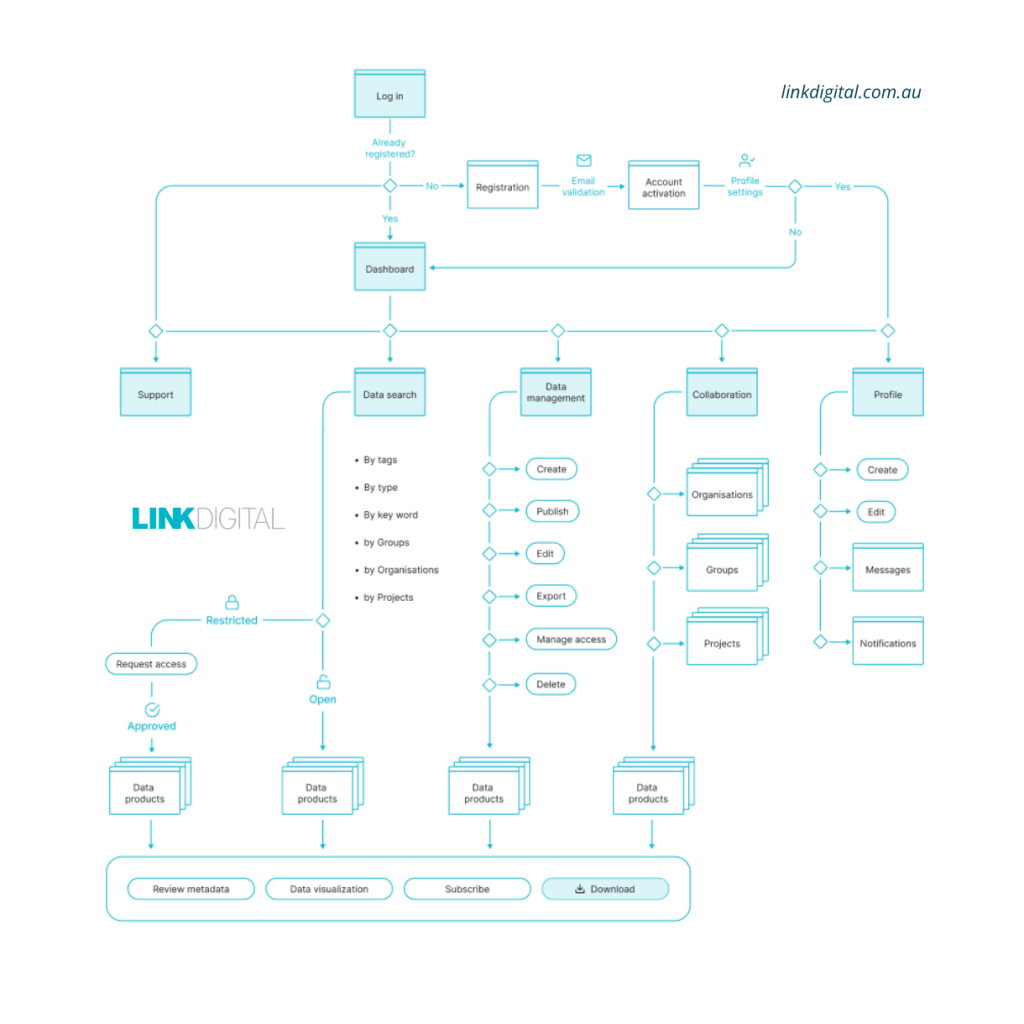An information asset register (IAR) is a catalogue which registers data assets held by an organisation and helps manage access to those data assets. Link Digital started working on a corporate IAR for the New South Wales Office of Environment and Heritage in 2015, and the application was rolled out in 2016. The IAR now services two NSW state government departments: Department of Planning Housing and Infrastructure (DPHI) and Department of Climate Change, Energy, the Environment and Water (DCCEEW).

The key aim of the IAR was to aid compliance with the NSW Government’s Open Data Policy. The policy seeks to embed open data in day-to-day government operations, including making data public for use by the community, researchers, business, etc, and for government staff to use it ‘to inform the design of policy, programs and procurement.’ The Office of Environment and Heritage wanted to develop an application that could make data accessible and available to users with accompanying metadata and data quality statements, to support the management of data and information resources as “assets” which can be used, reused and shared.

The IAR was developed as a catalogue and retrieval system (not a data storage system).
Staff use the IAR to register information assets from their business areas (e.g. datasets,databases, business applications, modelling tools, reports; whatever the business area thinks might be of use to others); with links for asset access and retrieval. Whilst files may be uploaded to the IAR for ease of retrieval, these are copies of master data stored elsewhere in corporate repositories.
Once registered, information assets are discoverable by other staff across the department.
The IAR replaced a pre-existing metadata portal for spatial data only. This was revamped using CKAN – the Comprehensive Knowledge Archive Network – open source software that can be configured and set up to function as a data platform once it is deployed and hosted on a web server. Approximately two thirds of the IAR’s records are published to the NSW Sharing and Enabling Environmental Data portal. A subset of IAR records is also published to the NSW Planning portal. All published records are syndicated to data.nsw.gov.au, the NSW Government’s central open data platform, which is in turn harvested by Australia’s national data portal. All these portals use CKAN, which facilitates seamless interoperability between them.
One of CKAN’s strengths as an internal data management platform is the ability to set predefined group and individual permissions to control the flow of critical internal data. In the IAR, these permissions work on three levels:
In addition to developing the IAR’s information governance module, which records mandatory governance information about each registered data asset, Link Digital developed a metadata module with a range of templates. The templates for geospatial data were made compliant with the current approved standard AS/NZS ISO 19115.1:2015, as recommended for use by ANZLIC – the Spatial Information Council, the peak intergovernmental organisation for the collection, management and use of spatial information in Australia and New Zealand.

Additionally, Link Digital developed an inbuilt validator in the IAR to confirm ISO19115 compliance. The validator takes Extensible Markup Language (XML) – the markup language that provides rules to define any data – as an input and checks whether it adheres to the latest standard based on the most up-to-date guidelines for this standard. This required Link Digital to infer requirements and implement a validator directly from the standard’s specification. Complexity within the standard required a careful observance to conditional elements and nested structures. This task would have been very difficult without the use of the ckanext-scheming extension, which has strong support for nested structures.
Link Digital also implemented functionality for the IAR to mint Digital Object Identifiers (DOIs) for selected data assets upon publication. A DOI is a unique combination of letters and numbers that are used to provide a permanent link to the location of an object, such as a document, image, dataset, or research paper, on the internet, even if its URL changes. This is particularly useful for grey literature, i.e., material not published in peer reviewed academic journals. DPHI belongs to a consortium of organisations, coordinated by the Australian Research Data Commons, which have DOI minting capabilities provided by DataCite. Link Digital provided a technical solution by which a DOI can be minted for both DPHI and DCCEEW via the IAR at the time of data asset publication to the SEED portal. Link Digital also hosts the IAR and helps with its day-to-day maintenance on an ongoing basis.
In summary, the IAR acts as an information catalogue for departmental staff, enabling them to discover, re-use and, where appropriate, to publish data assets . The IAR underpins the departments’ open data eco system, enabling compliance with the requirements of the state’s open data policies and publish information with metadata and data quality statements.
Get in touch and one of our CKAN experts will reach out.